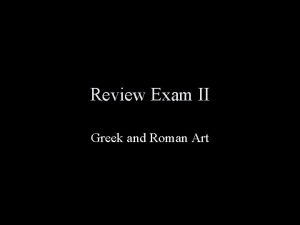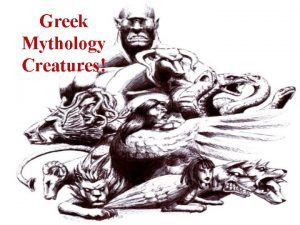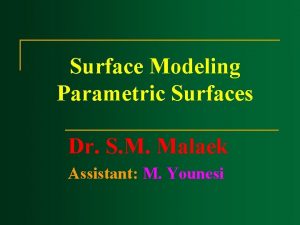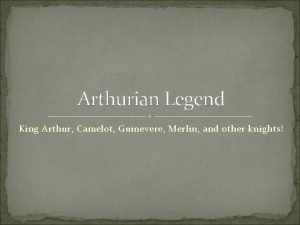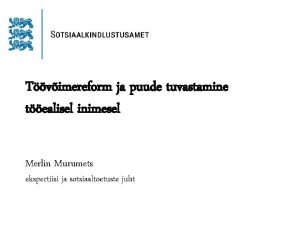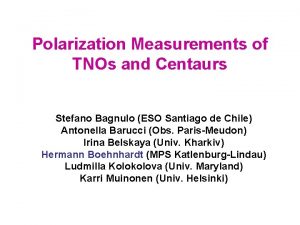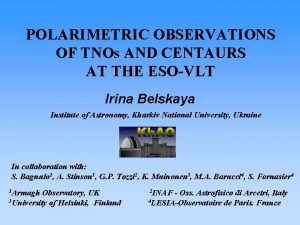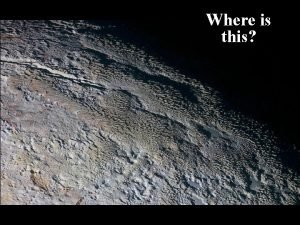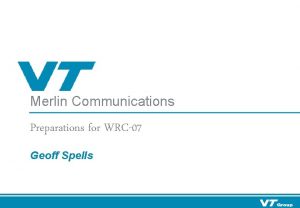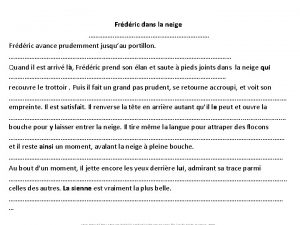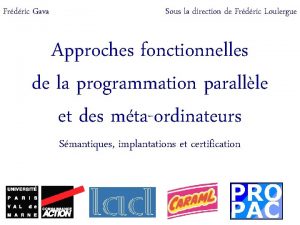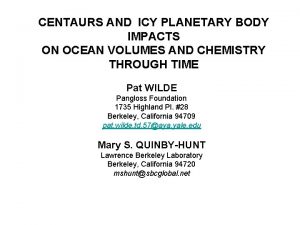Surface modelling of TNOs and Centaurs Frdric Merlin











- Slides: 11

Surface modelling of TNOs and Centaurs Frédéric Merlin & Maria Antonietta Barucci LESIA – Observatoire de Meudon - Re-analyse of several objects with SPITZER albedo - Comparison between the models of Hapke and Shkuratov International Workshop Trans Neptunian Objects Dynamical and Physical properties

Utilities of the models • Difficulties to analyse surface properties • Comparisons with several ices from laboratory measurements Licandro et al. , 2001 Cruikshank et al. , 1998 International Workshop Trans Neptunian Objects Dynamical and Physical properties

Short description of the models (1) –Hapke The reflectance r(μ 0, μ, g) of a surface consisting of particles of arbitrary shape in close proximity is given by. average single-scattering albedo w light multiple-scattering with H(μ) and H(μ 0) P(g) is the phase function, describing the single scattering radiation B(g) is the backscattering function, describing the opposition effect. –Shkuratov Multiple reflections are considered as multiple scattering in a onedimensional medium with same effective reflection coefficients. System of particles equivalent to a system of plates. • Different types of surface mixtures Molecules in separated zones Mixture of coarse particles size >> wavelength International Workshop Trans Neptunian Objects Dynamical and Physical properties

Short description of the models (2) • Optical constants, temperature and state dependance Each component is characterized by a couple of optical constants n, k. Each constants are determined for a given state and temperature Optical constants are determined in laboratory from transmission and reflexion measurements. The problem is difficult: optical thick has to be known, n and k must be computed by iteration processes Amorphous water ice Cristalline water ice Grundy & Schmitt, 1998 International Workshop Trans Neptunian Objects Dynamical and Physical properties

Short description of the models (3) Difference between the models for simple compounds The two models are based on geometric optic, particle size must be larger than wavelength. - Asymmetry parameter gives the depends of the particle properties inducing back or forward scattering scatterers. - It is important to know this value, which is different for each compound and each particle distribution. • Minor variations between the models International Workshop Trans Neptunian Objects Dynamical and Physical properties

Sample of TNOs and Centaurs – Use of albedo (1) • SPITZER data, albedo constraint. Object Albedo Diameter Dynamical type Taxonomic group Thereus 4. 4% 84 km Centaur BR 55565 2002 AW 197 12% 734 km Classical IR 47171 1999 TC 36 7. 3% 420 km Plutino RR Asbolus 5. 7% 77 km Centaur BR Chariklo 6. 8% 230 km Centaur BR • Thereus: Several observations show heterogeneous nature of the surface of this Centaur (Barucci et al. 2003, Merlin et al. 2005 and Licandro et al. 2005). Geographic mixture Hapke model Shkuratov model H 2 Oc - - 5% 50µm H 2 Oa - - 2% 34µm 3% 5µm Carbon 80% 15µm 74% 15µm 89% 15µm Ice-Th 4% 5µm - - Tit-Th 14% 50µm 1% 5µm 3% 50µm Tri-Th 2% 5µm 23% 6µm - -

Sample of TNOs and Centaurs – Use of albedo (2) • 55565: A classical kuiper belt object was observed by Doressoundiram et al. (2005). The low S/N level does not permit more information on the state of the water ice (amorphous or cristalline). Geographic mixture Hapke model Shkuratov model H 2 Oa 6% 5µm 23% 5µm 17% 5µm H 2 Oc - - 9% 5µm Carbon 48% 15µm 18% 15µm 24% 15µm Ice-Th 18% 5µm 14% 5µm Tit-Th 16% 5µm 4% 5µm - - Tri-Th 12% 5µm 37% 5µm 36% 5µm • 47171: It is a Plutino. None variation was observed (Merlin et al. , 2005) and indicate that this object may be relatively homogeneous. Geographic mixture Hapke model Shkuratov model H 2 Oa 3% 5µm 19% 13µm 25% 9µm H 2 Oc - - - Carbon 55% 15µm 25% 15µm 33% 15µm Ice-Th 10% 5µm - - Tit-Th 30% 5µm 26% 5µm 24% 5µm Tri-Th 2% 5µm 30% 5µm 18% 5µm

Sample of TNOs and Centaurs – Use of albedo (3) • Chariklo: This Centaur was observed several times in 2001 and 2002 by Dotto et al. (2003). No variations that let assume a homogeneous suface. Geographic mixture Hapke model Shkuratov model H 2 Oa 2% 5µm 12% 34µm 11% 5µm H 2 Oc 2% 5µm 13% 13µm 16% 15µm Carbon 65% 15µm 39% 15µm 36% 15µm Ice-Th 8% 50µm 4% 50µm 12% 50µm Tit-Th 18% 14µm 18% 20µm 25% 32µm Tri-Th 5% 16µm 14% 20µm - - • Asbolus: Observations done by Romon-Martin et al. (2002). No ices were detected on its surface and it may be covered by an irradiation crust. Geographic mixture Hapke model Shkuratov model H 2 Oa - - 6% 5µm H 2 Oc 1% 5µm 14% 5µm 5% 5µm Carbon 83% 15µm 50% 15µm 68% 15µm Ice-Th 5% 5µm 7% 31µm 7% 5µm Tit-Th 5% 5µm - - Tri-Th 6% 5µm 29% 12µm 14% 15µm International Workshop Trans Neptunian Objects Dynamical and Physical properties

Results • Differences found between the models – Ratio of abundances between the models Object H/S ice H/S Tholins H/S carbon 2002 AW 197 0. 92 1. 18 0. 72 1999 TC 36 0. 76 1. 69 0. 96 Thereus 0. 25 8 0. 83 Chariklo 0. 93 1. 02 Asbolus 1. 40 1. 70 0. 73 Object I/G ice I/G Tholins I/G carbon 2002 AW 197 3. 8 1. 3 0. 37 1999 TC 36 6. 3 0. 6 1 Thereus - 0. 83 0. 92 Chariklo 6. 25 1. 16 0. 6 Asbolus 14 2. 25 0. 6 Similar results for intimate mixtures Large differences between intimate and geographic mistures, bright and dark compounds do not influence in the same way. International Workshop Trans Neptunian Objects Dynamical and Physical properties

Discussion • Surface object comparisons require the use of similar model (geographic or intimate). Until now, we have no constraints to say which kind of mixture is the better • The surfaces are merely complex – we can also use in the same time of geographic and intimate mixture (see Dumas et al. Poster). • Improvement of the models Use better constraints about anisotropic scatterers (real simple scattering phase function) Stratification (Doute and Schmitt, based on Hapke model) Inclusions (allowed in Shkuratov method) International Workshop Trans Neptunian Objects Dynamical and Physical properties

Conclusion Models are not unique BUT they are the best approach to investigate the surface composition Need more optical constants !! International Workshop Trans Neptunian Objects Dynamical and Physical properties
 Alexander the great confronts darius iii
Alexander the great confronts darius iii Centaurs in norse mythology
Centaurs in norse mythology Surface modelling in cad
Surface modelling in cad King arthur and guinevere merlin
King arthur and guinevere merlin Volume and surface area of cone
Volume and surface area of cone Lateral surface of a triangular prism
Lateral surface of a triangular prism Geometric rotation
Geometric rotation Modelling relationships and trends in data
Modelling relationships and trends in data Problem solving and modelling task
Problem solving and modelling task Puude tuvastamine
Puude tuvastamine Merlin entertainments suppliers
Merlin entertainments suppliers Unin merlin
Unin merlin
